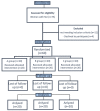Assessment of the Effectiveness of the Sonofeedback Method in the Treatment of Stress Urinary Incontinence in Women-Preliminary Report
- PMID: 35160108
- PMCID: PMC8837105
- DOI: 10.3390/jcm11030659
Assessment of the Effectiveness of the Sonofeedback Method in the Treatment of Stress Urinary Incontinence in Women-Preliminary Report
Abstract
Urinary incontinence is a common problem that affects postmenopausal women. This ailment has a negative impact on many aspects of life, significantly limiting everyday functioning related to professional work, physical activity or the intimate sphere. The aim of the study was to assess the effectiveness of the sonofeedback method in reducing the severity of urinary incontinence in postmenopausal women with a urinary incontinence problem. A total of 60 patients aged 45-65 with stress urinary incontinence, confirmed by a gynecologist, were qualified for the study. All persons qualified for the study were randomly assigned to study group A (n = 20), comparative B (n = 20) and control C (n = 20). Patients from group A were treated with sonofeedback of the pelvic floor muscles. In group B, the combined electrostimulation method was used with biofeedback training. Group C was a control group in which only the measured parameters were measured at the same time interval as those carried out in groups A and B. In all patients, three times: before the therapy, after the fifth procedure and after the end of the therapy, the incidence and severity of stress urinary incontinence were assessed-Gaudenz questionnaire and the intensity of urinary incontinence-a modified 1 h pad test. The obtained results have an application value giving the possibility of using effective therapy with sonofeedback in women in whom the recommended electrostimulation method cannot be used due to health and behavioral reasons.
Keywords: electrostimulation; sonofeedback; stress urinary incontinence.
Conflict of interest statement
The authors declare no conflict of interest.
Figures
Similar articles
-
Vaginal cone for postmenopausal women with stress urinary incontinence: randomized, controlled trial.Climacteric. 2012 Feb;15(1):45-51. doi: 10.3109/13697137.2011.593211. Epub 2011 Nov 8. Climacteric. 2012. PMID: 22066898 Clinical Trial.
-
Electromyographic characteristics of pelvic floor muscles in women with stress urinary incontinence following sEMG-assisted biofeedback training and Pilates exercises.PLoS One. 2019 Dec 2;14(12):e0225647. doi: 10.1371/journal.pone.0225647. eCollection 2019. PLoS One. 2019. PMID: 31790463 Free PMC article. Clinical Trial.
-
[Treatment of stress urinary incontinence with perineal biofeedback by using superficial electrodes].Actas Urol Esp. 2008 Jun;32(6):629-36. doi: 10.1016/s0210-4806(08)73899-3. Actas Urol Esp. 2008. PMID: 18655347 Spanish.
-
[Impact of biofeedback probes used in the self-rehabilitation of pelvic floor muscles in women with stress urinary incontinence. Literature review].Prog Urol. 2021 Jun;31(7):385-391. doi: 10.1016/j.purol.2021.01.006. Epub 2021 Feb 12. Prog Urol. 2021. PMID: 33583738 Review. French.
-
[Pelvic floor rehabilitation for female urinary incontinence: mechanisms of action].Prog Urol. 2013 Jun;23(8):491-501. doi: 10.1016/j.purol.2013.04.002. Epub 2013 May 2. Prog Urol. 2013. PMID: 23725579 Review. French.
Cited by
-
Conservative treatments for women with stress urinary incontinence: a systematic review and network meta-analysis.Front Med (Lausanne). 2024 Dec 4;11:1517962. doi: 10.3389/fmed.2024.1517962. eCollection 2024. Front Med (Lausanne). 2024. PMID: 39703522 Free PMC article.
-
Training Interventions Used in Postmenopausal Women to Improve Pelvic Floor Muscle Function Related to Urinary Continence-A Systematic Review.J Clin Med. 2025 Jul 7;14(13):4800. doi: 10.3390/jcm14134800. J Clin Med. 2025. PMID: 40649174 Free PMC article. Review.
References
-
- Nováková Z., Mašata J., Švabík K. Is it possible to estimate urethral mobility based on maximal urethral closure pressure measurements? Ceska Gynekol. 2019;84:115–120. - PubMed
LinkOut - more resources
Full Text Sources


